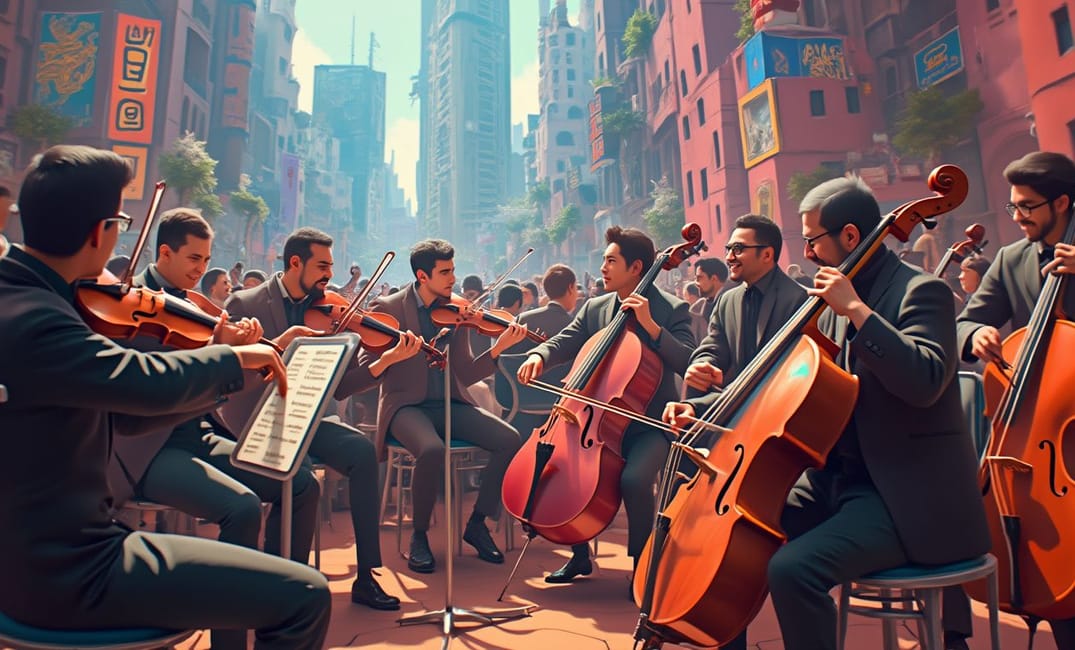Introduction: Harmonizing Invention and Imagination
Throughout human history, music has held a profound role, not only as an art form but also as a catalyst for invention and technological innovation. It pulses at the heart of culture, stirring emotions and inspiring actions. This entry explores the intricate entwining of music and technology, highlighting how humankind's auditory pursuits have driven technological innovation, fueled scientific exploration, and shaped societies.
Prelude: The Interplay of Sound and Invention
Long before digital soundscapes or electrical instruments, music inspired technological curiosity and innovation, influencing the development of tools and techniques in unexpected ways.
Ancient Innovators: Crafting the Obscure
- The Genesis of Musical Instruments: The earliest musical instruments arose from primitive craft—flutes carved from bird bones, drums fashioned from hollow logs. These creations marked humanity's first explorations into acoustics, experimentation that laid the foundations for artisanal and later industrial craftsmanship.
- Mathematical Musings in Music: Pythagoras’s fascination with musical harmony fueled insights into mathematical relationships, demonstrating an intrinsic link between numerical ratios and melodic patterns. His work sowed early seeds of acoustical science and tuning systems, connecting musical intervals with numeric ratios—a discovery pivotal in musical and mathematical developments.
Medieval Mechanical Marvels
- The Organ: First Complex Machinery: The pipe organ stands as one of medieval ingenuity's triumphs, translating air flow into musical sound. Its complex mechanism of keys, pipes, and bellows required precision engineering, inspiring developments in wind and hydraulic systems that would echo through technology in subsequent centuries.
- Clockwork Creations and Musical Automata: In an era where timekeeping aligned with musicality, medieval clockwork fascinated artisans who created musical automata—early robots animated by gears and levers that imbued mechanical precision with auditory artistry, foreshadowing the intersection of technology and entertainment.
The Symphony of Modern Invention and Musical Pursuits
Music's quest for expression catalyzed many modern technological inventions, influencing audio technologies and shaping broader societal trends.
The Phonograph: Capturing Soundwaves
- Edison's Acoustic Legacy: Thomas Edison's phonograph revolutionized sound recording, transforming the music industry by enabling reproduction and dissemination of audio. This mechanical marvel marked the birth of audio playback technology and preluded the rise of media industries.
- Cultural Impacts of Sound Recording: As sound recording democratized access to music, it diversified the cultural landscape, enhancing cross-cultural exchange and accessibility, weaving widely varying musical styles into the global cultural tapestry.
Radio Waves and Amplified Voices
- Wireless Wonders and Broadcasting Frontiers: The development of radio brought music to the masses, transmitting across distances once unbridgeable. Music became integral in unifying distant populations, broadcasting cultural narratives and influencing public sentiment through soundwaves.
- Amplification Innovations: As music embraced amplification, innovations like the vacuum tube amplifier and electric guitar transformed sound production. Engineers shaped electronics to cater to music's demands, contributing to advancements in power circuits and sound amplification that extended beyond the musical domain.
Digital Revolutions: Algorithmic Arrangements and Beyond
In the digital age, music intersects with technology in form and function, shaping complex systems and interactions through innovation and artistry.
Synthesized Sounds and Digital Composition
- Synthesizers and Circuitry: The advent of synthesizers—machines capable of creating artificial sounds—reshaped musical horizons, employing oscillators and filters to generate diverse tones. This explored new auditory realms and became pivotal in developments in digital signal processing and electronic circuitry.
- Algorithmic Composition and AI: Computer algorithms now curate compositions, demonstrating AI's role in generating symphonic arrangements and personalized soundtracks. AI assists in analyzing compositions, offering composers new creative possibilities, and furthering research into artificial creativity and machine learning.
Digital Distribution and Interactive Auditory Experiences
- Streaming Platforms and Musical Access: Digital platforms, epitomized by streaming services, revolutionized music distribution, altering consumer access patterns and catalyzing music's integration into virtual and augmented realities. This fueled infrastructure expansions aligned with data transmission and digital copyright management.
- Interactive Technologies and Immersive Soundscapes: Technologies like virtual reality (VR) harness interactivity, immersing audiences in multichannel soundscapes that synchronize with visual elements, crafting experiences that transcend traditional concert settings. Innovations in VR acoustics and sound spatialization influence auditory research across entertainment and therapeutic domains.
Harmonizing the Future: Challenges and Opportunities in Music Technology
As music technology evolves, it offers profound opportunities and presents ethical challenges, inviting humanity to contemplate the essence of creativity and technology's role.
Sustainability and Innovation in Music Production
- Eco-Friendly Practices in Manufacturing: As the demand for electronic instruments escalates, sustainable production methods emerge, prioritizing recyclable materials, energy efficiency, and reduced emissions. Pioneering manufacturers and musicians advocate for eco-friendly innovations across music production industries.
- Open-source Platforms and Accessibility: The open-source movement democratizes access to music technology, enabling creators worldwide to experiment, modify, and innovate. This fosters collaborative development and empowers diverse musical traditions by providing platforms to share and evolve creative tools.
Cultural Preservation and Global Narratives
- Preserving Indigenous Musical Heritage: Digital archives and recording technologies play crucial roles in preserving endangered musical traditions, ensuring they remain vibrant as our cultural dynamics evolve. These archives serve as invaluable resources, fostering global understanding through sound and storytelling.
- Constructing Inclusive Narratives: Music technology amplifies diverse voices, shaping inclusive narratives that celebrate global cultural diversity. By integrating indigenous rhythms with contemporary electronic music, technology bridges ancient musical heritage with modern auditory landscapes.
Conclusion: The Melodic Path of Innovation
The interplay between music and technology serves as a testament to humanity's enduring creativity and desire for harmonious symbiosis. As technological barriers dissolve through musical exploration, new opportunities arise for cross-disciplinary innovation. The rhythm of human progress continues, echoing past melodies and harmonizing future endeavors in a dance of invention, artistry, and shared experience.
"Innovation is the harmonious symphony of technology and sound, weaving the notes of progress as humanity's eternal dance—a testament to creativity and the boundless frontier of imagination."
INVENTIONS, FUTURE PROSPECTS, TECHNOLOGY, SOUND, CREATIVITY, HISTORY, INNOVATION, MUSIC, DIGITAL AGE, CULTURE

